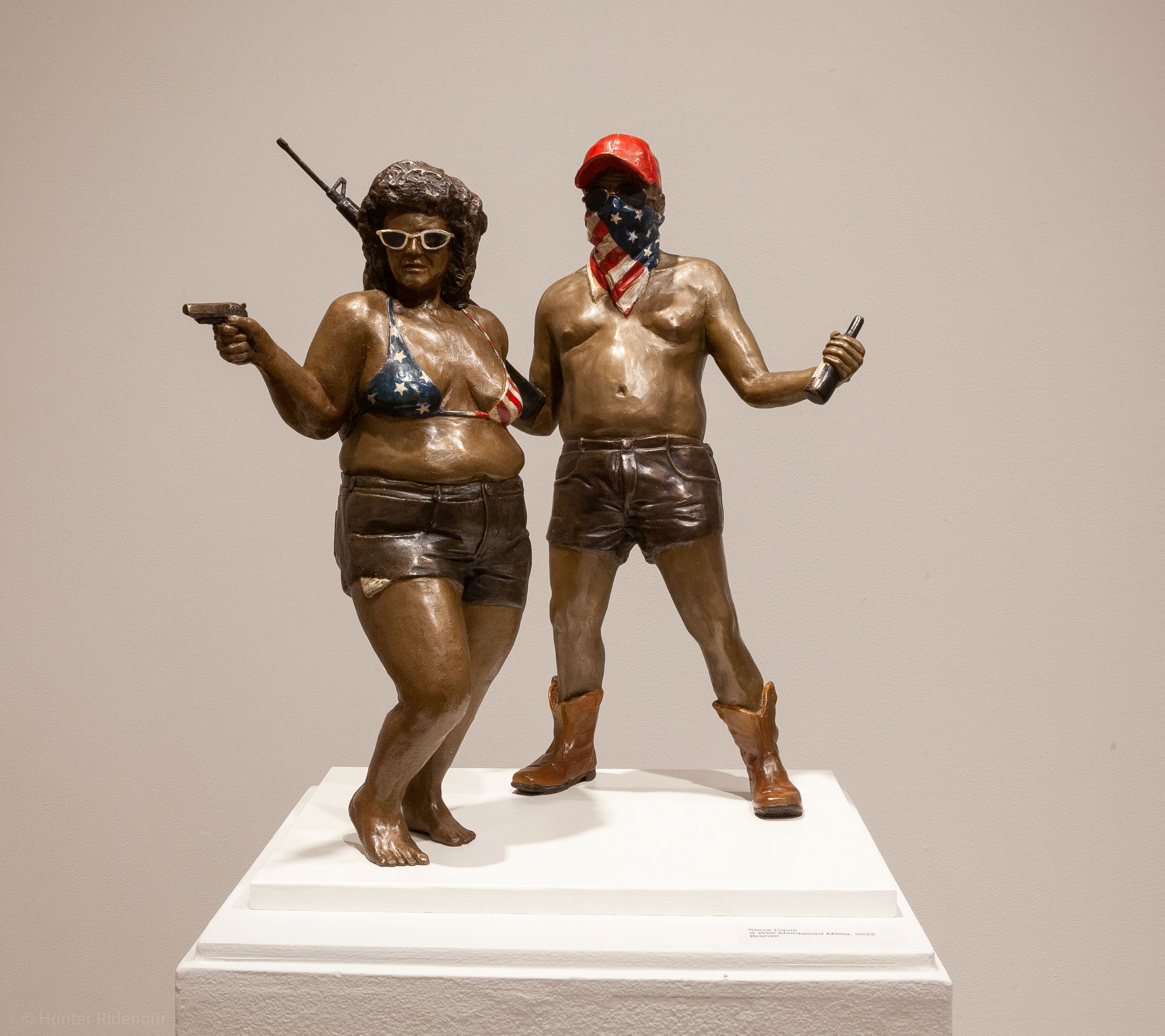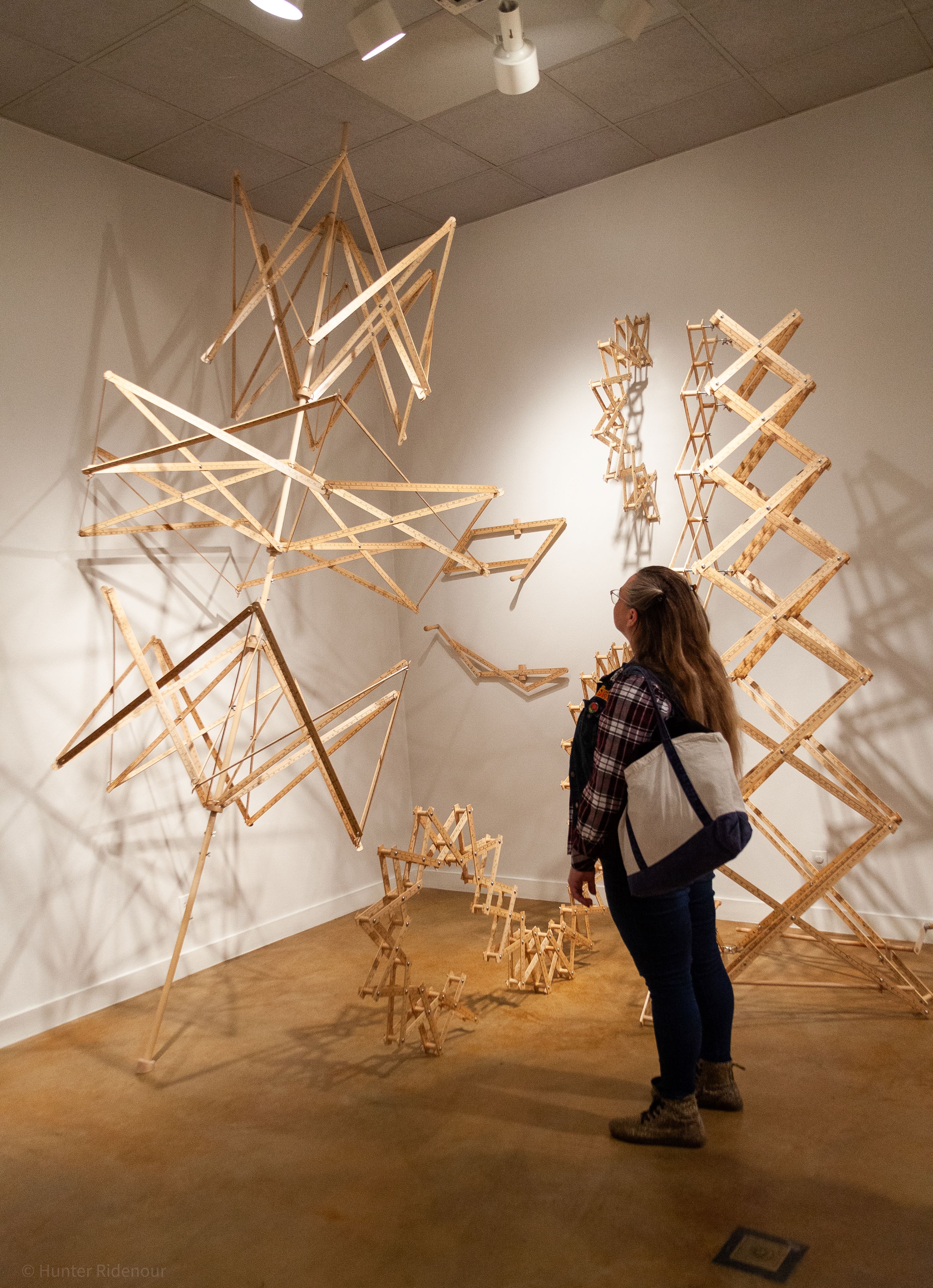Spatial Arts Faculty Exhibition

Steve Davis, A Well Maintained Militia, 2022, Bronze
The Natalie and James Thompson Art Gallery is pleased to present
this periodic opportunity to view recent works by current faculty in the
Spatial Arts area: Lynn Dau, Steve Davis, Yvonne Escalante, Crystal
Kamoroff, Adam Shiverdecker, Monica Van den Dool and Shannon
Wright.
Featured are a divergent group of artists who, although displaying
a wide range of media, style, and technique, share an interest in
working with spatial arts media and a devotion to teaching. All of
these artists have individually received noteworthy acclaim for their
works. As a group, they combine significant successes in regional,
national, and international exhibitions, public art commissions, and
museum collections, as well as numerous grants and awards. We are
delighted to have this opportunity to feature their thoughtfulness,
craftsmanship, and vision in this special display.
In conjunction with the opening of this exhibition, each exhibiting
artist will speak about their work, its context, and its development
as part of a walk-through in the Thompson Gallery, which will be
held from 5-6 p.m. on January 31, 2023. This presentation and the
following opening reception, held immediately afterward from
6-7:30 p.m., are free and open to the public.

Shannon Wright, Number Crunchers, 2020, Wooden yardsticks and hardware
Artist Bios
Lynn Dau is a sculptor and spatial art instructor at San Jose State University (SJSU). She
was born and raised in Los Angeles, California and moved to the San Francisco Bay
Area in 1993 after living in Anchorage, Alaska. Before completing her MFA in Spatial
Art at SJSU in 2017, she obtained a BA in Behavioral Sciences from National University
and law degree from UC Davis, King Hall School of Law. After practicing as a criminal
defense attorney and having two children she returned to school to study fine art.
Since graduating Dau has been employed as a university lecturer teaching beginning
sculpture classes. She has taught at Gavilan College, Santa Clara University and SJSU.
Her art practice explores themes related to familial dynamics, gender equity, parenting
and consumerism. Her primary medium of choice is the found object from which she creates
assemblages using a variety of fabrication techniques. She has exhibited her work
at venues throughout her home state of California and Nationally.
Steve Davis grew up in Charleston, South Carolina, under power lines in a house with flaking lead-based
paint. Both of his parents smoked heavily and he ate Spaghetti-Os almost every night
for dinner. His first creative endeavor came at 6 years old after drinking all of
his Dad's half empty beers that were lying around the house. Not sure what was happening
other than the room spinning, Davis tried to hold back vomiting by trying to draw
straight lines on paper. The result was oddly a depiction of a sailboat. Over
the years when the voices would become too much to stomach, Davis would find solace
in drawing and building model airplanes. Once in high school, having discovered that
he was way too awkward around people, especially the opposite sex, Davis retreated
further into the abyss of art. In college, he became addicted to Coca Cola and became
an art major. The increased caffeine consumption gave him the stamina needed to spend
way too much time in the studio. However, not being the most proactive in his education,
Davis failed to plan one semester resulting in all of the painting and drawing classes
being full. Not wanting to sit out a semester he enrolled in a sculpture class. Thinking
he would be making clay ashtrays and birdhouses for a semester, Davis was surprised
to find that someone would be foolish enough to let him play with explosive toys such
as furnaces and torches. From there, he found it hard to go back to mediums and techniques
where the spectre of physical injury and property damage were not present. After
college Davis would find himself in Hawaii where he got to burn more things by working
with a glass artist. There, he was taught proper ways to fake it until he made it
with a welder. After a few years, Davis made one, of an ever increasing long list
of bad choices, and followed his girlfriend to Ohio... from Hawaii... in February.
It was there in Ohio, while working as a welder and steel erector in sub zero temperatures
for $11 an hour, Davis soon realized that there was certainly some other bad choice
that was better. He applied to Graduate School for a Massive Financial Abyss (MFA)
degree in the most expensive part of the country where he was accepted into the institutional
dysfunction. After proving that he was the cheapest, and not the worst candidate
for an open position, he started running the Art Foundry at San Jose State University,
where he gets to draw, burn stuff, and play with sail boats to this day. Having
had enough beer when he was 6, and realizing that Coca Cola was making it hard to
tie his shoes, Davis lives quietly on water and cheese.
Yvonne Escalante is an artist and educator who lives and works in San José, California. Raised in Southern California, Escalante received her BFA from California State University, Long Beach and later earned her MFA from San José State University, where she now runs the Jewelry and Small Metals area. Her art utilizes traditional metalsmithing techniques in multi-media sculptures and installations that explore themes of cultural, social, and environmental justice. Escalante’s work has been exhibited nationally, including the deYoung Museum, the Contemporary Jewish Museum, and the Oakland Museum of California.
Crystal Kamoroff is an artist and artist educator from Northern California. She received her BFA from
SJSU and MFA from BGSU. Crystal teaches ceramics at various institutions throughout
the Bay Area and also facilitates ceramic programming at the Randall Museum in San
Francisco. Clay is central to her sculpture practice and she also works with other
materials and media as needed. Crystal loves to share and empower people with the
autonomy and freedom of creative practices. She is currently working towards larger
projects that combine visual, performing and healing arts that envision new ways of
connecting and supporting one another towards healing the planet.
Adam Shiverdecker (b. 1980, Arcanum, Ohio) is an artist and educator living in Oakland, California. His work has been shown widely, including recent exhibitions at Museum of Craft and Design in San Francisco, Everson Museum of Art, The Nelson-Atkins Museum of Art, Mindy Solomon Gallery, Side Gallery (Barcelona, Spain) and San Jose Institute of Contemporary Art. His work has been nationally recognized; Adam was named an emerging artist by NCECA and Ceramics Monthly, was the recipient of the 2014 Victor Spinski Emerging Artist Award and was named Distinguished Alumni by the University of South Carolina in 2019. He has held multiple artist residencies, including The Archie Bray Foundation, Greenwich House Pottery, and the Tyler School of Art at Temple University. He has participated on panels at College Art Association and The National Council on Education for the Ceramic Arts (NCECA) and he has presented at numerous universities and conferences. Adam is currently Associate Professor of Spatial Art at San José State University.
Cassandra Straubing’s sculptural work addresses issues of domestic, agricultural and industrial labor within our current political climate using multiple mediums and processes including glass and mixed media fabrication. She employs a wide range of glass-forming techniques including casting, blowing, hot forming and non- traditional glass processes to create her artwork. Additionally, she practices beekeeping and permaculture on her own sustainable farm. Permaculture is the harmonious integration of land, people, resources and the environment through a mutually beneficial symbiosis. It is the conscious design and maintenance of farming and ecosystems, sustainably providing food, energy, and shelter. It has the diversity, stability, and resilience of a closed loop ecological community. She believes that without permanent agriculture there is no possibility of a stable social order.
Monica Van den Dool is a ceramic sculptor residing in beautiful Oakland CA. She received an MFA from
Montana State University, Bozeman in 1995 and a BA in English from Santa Clara University
in 1990. Named a NCECA Emerging Artist in 2002, her work has been exhibited at various
national venues, including the San Jose Museum of Art, the DeSaisset Museum at Santa
Clara University, and the Arizona State University Art Museum Ceramics Research Center.
Her work is included in the collections of the Archie Bray Foundation (MT), the DiRosa
Preserve (CA), the Crockett Museum in Sacramento, and the Arizona State University
Ceramic Research Center, and her artist residencies include the Archie Bray Foundation,
Watershed Center for the Ceramic Arts, and the LH Project. She has taught ceramics
at several Bay Area universities, including San Jose State, California College of
the Arts, and the University of California, Berkeley.
Shannon Wright is a sculptor and installation artist based in San José, California. Born in Baton Rouge, Louisiana, Wright grew up chiefly in Sydney, Australia, and then spent her artistically-formative years among the iron trestle bridges and turn-of-the-last-century hydroelectric power plants and foundries of Richmond, Virginia. Wright earned her BFA in Sculpture from Virginia Commonwealth University and her MFA in Time Arts from The School of the Art Institute of Chicago. She is a professor and the coordinator of the Spatial Art program at San Jose State University. Wright is represented by ADA Gallery in Richmond, Virginia.
Wright’s recent work reacts to the imposition of rigid structure onto natural systems in order to eliminate ambiguity and unpredictability. Several of Wright’s projects are a response to the modernist prioritization of pure economic utility, which has led to the emergence of non-places or atopias disconnected from geography and history. In recent years, Wright has built structures that suggest hybrids of street furniture, playground equipment, and other modular, mass-produced industrial objects. Wright has a longstanding fascination with modular systems and articulated connections.
Artist Walkthrough and Exhibition Opening Reception (click to view video)
Tuesday, March 21, 2023
Artist Walkthrough: 5 - 6 p.m.
Opening Reception: 6 - 7:30 p.m.
Natalie and James Thompson Art Gallery
Gallery Hours
Tuesdays 10 a.m. - 4 p.m.; 6 p.m. - 7 p.m.
Monday, Wednesday, Friday 10 a.m. - 4 p.m.
and by appointment
Natalie and James Thompson Art Gallery
Department of Art and Art History
San José State University